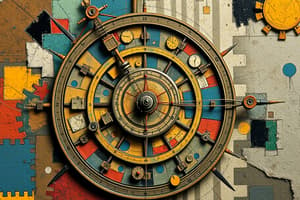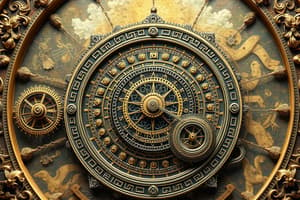Podcast
Questions and Answers
What is the Antikythera mechanism?
What is the Antikythera mechanism?
- An ancient Greek hand-powered analogue computer designed to predict astronomical positions and eclipses decades in advance (correct)
- An ancient Greek musical instrument
- An ancient Greek sculpture
- An ancient Greek weapon
When was the Antikythera mechanism discovered?
When was the Antikythera mechanism discovered?
- 2008
- 1920
- 2000
- 1901 (correct)
What is the Antikythera mechanism made of?
What is the Antikythera mechanism made of?
- Gold gears
- Silver gears
- Bronze gears (correct)
- Iron gears
What is the largest gear in the Antikythera mechanism?
What is the largest gear in the Antikythera mechanism?
What is the function of the Saros dial in the Antikythera mechanism?
What is the function of the Saros dial in the Antikythera mechanism?
What is the function of the Metonic dial in the Antikythera mechanism?
What is the function of the Metonic dial in the Antikythera mechanism?
What is the function of the differential gear operation in the Antikythera mechanism?
What is the function of the differential gear operation in the Antikythera mechanism?
What is the purpose of the Antikythera mechanism?
What is the purpose of the Antikythera mechanism?
Where is the Antikythera mechanism currently kept?
Where is the Antikythera mechanism currently kept?
Flashcards
Antikythera Mechanism
Antikythera Mechanism
Ancient Greek device predicting astronomical positions and eclipses.
87 BC
87 BC
Estimated construction date of the Antikythera Mechanism.
37 Gears
37 Gears
Number of meshing bronze gears in the Antikythera Mechanism.
Rhodes
Rhodes
Signup and view all the flashcards
Zodiac Dial
Zodiac Dial
Signup and view all the flashcards
Saros dial
Saros dial
Signup and view all the flashcards
Over 30 Gears Made of Bronze
Over 30 Gears Made of Bronze
Signup and view all the flashcards
Egyptian Calendar
Egyptian Calendar
Signup and view all the flashcards
Archimedes
Archimedes
Signup and view all the flashcards
Study Notes
Antikythera Mechanism: Ancient Analogue Astronomical Computer
-
The Antikythera mechanism is an ancient Greek hand-powered analogue computer designed to predict astronomical positions and eclipses decades in advance.
-
It was discovered among wreckage retrieved from a shipwreck off the coast of the Greek island Antikythera in 1901.
-
The device was found as one lump, later separated into three main fragments, which are now divided into 82 separate fragments after conservation efforts.
-
Four of these fragments contain gears, while inscriptions are found on many others. The largest gear is approximately 13 centimetres (5.1 in) in diameter and originally had 223 teeth.
-
The mechanism was designed and constructed by Greek scientists and has been dated to about 87 BC, between 150 and 100 BC, or 205 BC.
-
It is believed to have been constructed before the shipwreck, which has been dated by multiple lines of evidence to approximately 70–60 BC.
-
In 2008, a team from Cardiff University used computer x-ray tomography and high resolution surface scanning to image inside fragments of the crust-encased mechanism and read the faintest inscriptions that once covered the outer casing of the machine.
-
It is suggested that the mechanism had 37 meshing bronze gears enabling it to track the movements of the Moon and the Sun through the zodiac, predict eclipses, and model the irregular orbit of the Moon.
-
The mechanism was operated by turning a small hand crank (now lost), which was linked via a crown gear to the largest gear, the four-spoked gear visible on the front of fragment A, gear b1.
-
The mechanism was most likely constructed in Rhodes, a busy trading port and a centre of astronomy and mechanical engineering, home to astronomer Hipparchus.
-
The original mechanism apparently came out of the Mediterranean as a single encrusted piece and fractured into three major pieces soon afterwards.
-
All known fragments of the mechanism are now kept at the National Archaeological Museum, Athens, along with artistic reconstructions and replicas, to demonstrate how it may have looked and worked.The Antikythera Mechanism and its features:
-
The mechanism may have omitted the five days of the Egyptian intercalary month in some reconstructions.
-
The Zodiac dial on the front contains Greek inscriptions of the members of the zodiac, adapted to the tropical month version.
-
The Zodiac dial also has single characters that mark the locations of longitudes on the ecliptic for specific stars, keyed to a parapegma.
-
The mechanism had at least two pointers, a lunar pointer indicating the position of the moon and a mean Sun pointer indicating the current date.
-
The Moon position was not a simple mean Moon indicator, but approximated the acceleration and deceleration of the Moon's elliptical orbit.
-
The mean Sun position is the current date, but there is speculation that there may have been a "true sun" pointer to track the elliptical anomaly of the Sun.
-
The mechanism also calculated the timing of panhellenic athletic games, including the Ancient Olympic Games, and used the Epirote calendar.
-
The back of the mechanism has five dials, including the Metonic and Saros dials and the Games, Callippic, and Exeligmos indicators.
-
The Metonic dial covers 235 months in five rotations of the dial, with the pointer pointing to the synodic month and the cell containing Corinthian month names.
-
The Saros dial is the main lower spiral dial on the rear of the mechanism and is used to predict solar and lunar eclipses.
-
There is debate over whether the mechanism had indicators for all five of the planets known to the ancient Greeks.
-
The mechanism has at least 30 gears, with the teeth in the form of equilateral triangles and an average circular pitch of 1.6 mm.The Antikythera Mechanism: A Complex Ancient Greek Astronomical Calculator
-
The Antikythera Mechanism is an ancient Greek astronomical calculator believed to have been built around 200 BCE.
-
The mechanism was discovered in 1901 in the Antikythera shipwreck, which dates back to the first century BCE, near the Greek island of Antikythera.
-
The mechanism is made up of over 30 bronze gears and is housed in a wooden case that measures approximately 33 x 18 x 10 cm.
-
The mechanism was designed to predict astronomical positions and eclipses for calendrical and astrological purposes.
-
The mechanism has six pointers that display the positions of the Sun, Moon, and five planets known to the ancient Greeks.
-
The mechanism also has a dial that displays the 365-day Egyptian calendar, a dial that displays the 235-month Metonic cycle, and a dial that displays the 223-month Saros cycle.
-
The mechanism also models the phases of the Moon and has a differential gear operation that measures the angle between the Sun and Moon pointers.
-
The mechanism has five trains of gears that are driven by the main drive train and control the movements of the pointers.
-
The function of some gears is unknown as they did not survive in the wreckage, and their functions were deduced from the remains of the dials on the back face.
-
There have been several proposed gear schemes to emulate the missing gears and improve the mechanism's accuracy, including proposals by Michael Wright, Evans, Carman, and Thorndike, and Freeth and Jones.
-
Investigations by Freeth and Jones reveal that their simulated mechanism is inaccurate due to inadequacies in the Greek theory of planetary movements and mechanical inaccuracies due to hand-built gears.
-
Cicero's De re publica mentions two machines built by Archimedes that some modern authors consider as some kind of planetarium or orrery, predicting the movements of the Sun, the Moon, and the five planets known at that time.The Antikythera mechanism: An ancient Greek computer
-
The Antikythera mechanism is an ancient Greek analog computer designed to predict astronomical positions and eclipses for calendrical and astrological purposes.
-
It was discovered in 1901 in the Antikythera shipwreck off the coast of the Greek island of Antikythera.
-
The mechanism is dated between 150 and 100 BCE and is the earliest known complex geared mechanism.
-
It is not known how the mechanism came to be on the ship, but it has been suggested that it was being transported from Rhodes to Rome, possibly to Julius Caesar.
-
The mechanism was lost for over 2000 years until its rediscovery in 1901 by a group of sponge divers.
-
The mechanism is made up of at least 30 bronze gears and is housed in a wooden case with inscriptions explaining its functions.
-
The mechanism was able to display the phase of the moon, the position of the sun and moon in the zodiac, the date according to a solar calendar, and the timing of lunar and solar eclipses.
-
The mechanism also had a mechanism that simulated the movement of the sun and moon through the zodiac.
-
The mechanism was so sophisticated that it was not until the 14th century that anything similar was produced in Europe.
-
The discovery of the Antikythera mechanism has led scientists to believe that there was an ancient Greek tradition of complex mechanical technology that was later transmitted to the Byzantine and Islamic worlds.
-
The mechanism has been reconstructed by scientists and replicas are on display in museums around the world.
-
The discovery of the Antikythera mechanism has revolutionized our understanding of ancient Greek technology and has given insight into the sophistication of ancient Greek science and engineering.
Studying That Suits You
Use AI to generate personalized quizzes and flashcards to suit your learning preferences.




